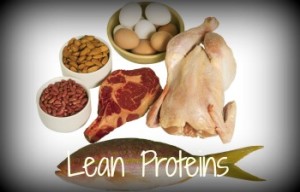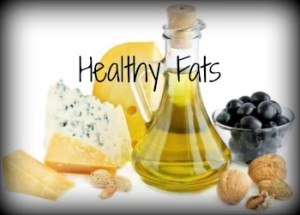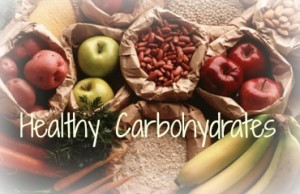For the most part, people know that they need to eat a balanced diet. What exactly that balanced diet looks like is less clear. For today, let’s talk about proteins, fats, and carbohydrates. All three are vital components of your balanced diet.
Proteins are a vital component of every cell in our body that are constantly being broken down and replaced. Our muscles are made of proteins! The protein in our diet that we eat is broken down into amino acids and used to replace those in our body. Protein comes from various sources; meat, fish, dairy, and beans – just to name the most common. All protein; however, is not created equal. You want to choose lean sources of protein. For example, choose sources with less saturated fat or plant sources of protein (tofu, beans, quinoa), organically grown meats, wild fish instead of farm raised fish. Your daily protein requirements depend on your goals. If you are trying to build muscle you need approximately 2g/kg body weight. If you are trying to lose fat, it is recommended that you eat approximately 2.2g/kg body weight. If you want to maintain, you need approximately 1.4g/kg body weight. (To find your body weight in kg – divide your body weight in pounds by 2.2.). This is a general guideline to help you customize your menu.
to replace those in our body. Protein comes from various sources; meat, fish, dairy, and beans – just to name the most common. All protein; however, is not created equal. You want to choose lean sources of protein. For example, choose sources with less saturated fat or plant sources of protein (tofu, beans, quinoa), organically grown meats, wild fish instead of farm raised fish. Your daily protein requirements depend on your goals. If you are trying to build muscle you need approximately 2g/kg body weight. If you are trying to lose fat, it is recommended that you eat approximately 2.2g/kg body weight. If you want to maintain, you need approximately 1.4g/kg body weight. (To find your body weight in kg – divide your body weight in pounds by 2.2.). This is a general guideline to help you customize your menu.
Fats are found in our bodies and in our foods. We need dietary fats for fuel and to help the body function. Fats are needed to dissolve specific vitamins, line cell membranes, protect vital organs, insulate us and prevents heat loss, for hormone production, make up the skin, and for normal development in kids. While we do NEED fat in our diet and on our bodies, there are different forms of fats. Saturated fats are those fats that are hard at room temperature (i.e. butter, bacon, cheese, etc.). Saturated fats typically come from animal sources. Transfats, also found in animal sources, can be synthetically made through processing the natural fat. These increase your bad cholesterol (LDL) and decrease your good cholesterol (HDL). Then there are the unsaturated fats: these are the healthier fats. Unsaturated fats reduce your risk of heart disease and diabetes and improve your cholesterol levels. Examples of unsaturated fats include olive oil, avocados, peanut oil, nuts, and poultry. Omega-3s are an example of a polyunsaturated fat. They provide the added benefit of lowered blood pressure and reduced risk of coronary artery disease. Examples of omega-3s include fatty cold water fish (salmon, herring), flaxseeds, and walnuts.
on our bodies, there are different forms of fats. Saturated fats are those fats that are hard at room temperature (i.e. butter, bacon, cheese, etc.). Saturated fats typically come from animal sources. Transfats, also found in animal sources, can be synthetically made through processing the natural fat. These increase your bad cholesterol (LDL) and decrease your good cholesterol (HDL). Then there are the unsaturated fats: these are the healthier fats. Unsaturated fats reduce your risk of heart disease and diabetes and improve your cholesterol levels. Examples of unsaturated fats include olive oil, avocados, peanut oil, nuts, and poultry. Omega-3s are an example of a polyunsaturated fat. They provide the added benefit of lowered blood pressure and reduced risk of coronary artery disease. Examples of omega-3s include fatty cold water fish (salmon, herring), flaxseeds, and walnuts.
It is unfortunate that carbohydrates are touted as “bad” and fad diets say NO carbs. You need them! Like anything else, there are “good” choices, and there are “bad” choices. Carbs are needed to fuel your body for activity and for certain body functions. Carbs are broken down into glucose in the body, the main source of “food” for your brain & your muscles! Therefore, you must eat carbs to fuel your brain and your body! Exercise stimulates your muscles, which use glucose for fuel. During exercise, your blood glucose level is reduced. This is why you may feel nauseous or dizzy/lightheaded during a workout if you’ve not had enough to eat. Your muscles are in demand of glucose so they are pulling the glucose from other parts of your body (i.e. digestion, brain, etc.). If you feel this way during a workout, it means you didn’t have proper carbs to eat before the workout. Good sources of carbohydrates include organic whole grains, fresh garden vegetables, beans, and seasonal fruits. Your daily carbohydrate requirements depend on your goals. If you are trying to build muscle, it is recommended that you eat approximately 6-7g/kg body weight. If you are trying to lose fat, you need approximately 2-4g/kg body weight. If you want to maintain, you need approximately 5-6g/kg body weight. This is a general guideline to help you customize your menu.
your brain and your body! Exercise stimulates your muscles, which use glucose for fuel. During exercise, your blood glucose level is reduced. This is why you may feel nauseous or dizzy/lightheaded during a workout if you’ve not had enough to eat. Your muscles are in demand of glucose so they are pulling the glucose from other parts of your body (i.e. digestion, brain, etc.). If you feel this way during a workout, it means you didn’t have proper carbs to eat before the workout. Good sources of carbohydrates include organic whole grains, fresh garden vegetables, beans, and seasonal fruits. Your daily carbohydrate requirements depend on your goals. If you are trying to build muscle, it is recommended that you eat approximately 6-7g/kg body weight. If you are trying to lose fat, you need approximately 2-4g/kg body weight. If you want to maintain, you need approximately 5-6g/kg body weight. This is a general guideline to help you customize your menu.
BOTTOM LINE: Choose whole grains, unprocessed, unrefined, and high fiber carbs and aim for 40-50% of your total daily calories from carbs. Choose unsaturated fats and aim for NO more than 30% of your total daily calories from fat (unsaturated). Choose lean sources of protein and aim for 20-35% of your total daily calories from protein. Happy eating!
